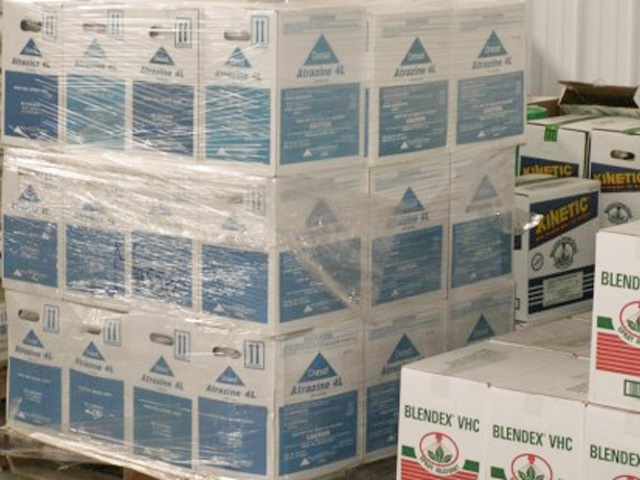Pesticide Storage Refresher
Storing Pesticides This Winter? Read These Four Safety Tips First.
ROCKVILLE, Md. (DTN) -- Tempted to stockpile your favorite pesticide for use next year? Proceed carefully. Temperature swings, state regulations and theft risks are just a few things to consider as you stock up or hold over ag chemicals.
Amid pesticide shortages and soaring prices, DTN checked in with Fred Whitford, director of Purdue Pesticide Programs, on how to proceed if you are storing pesticides for the first time, for longer than normal or in greater volumes than normal.
His top tips? Only buy what you need, read those labels carefully, select a good storage location and work to protect it.
1.DON'T HOARD
Tempting as it might be amid short supplies, Whitford urges farmers not to hoard pesticides. "We will get through this -- you don't need to hoard," he said. "There's nothing wrong with buying ahead for the next year, but don't overbuy just because of current availability." Keep in mind that as new products and crop traits are advanced, you might find that you don't want the same pesticides two or three years down the road, he added.
Also, depending on your state, there might be a different set of regulations for the storage of larger quantities of pesticides, Whitford said. Growers stockpiling pesticide products should be aware that they could fall under different bulk storage containment regulations, he warned.
2.LOOK AT THE LABEL -- AND DATE IT
Read the label carefully for each pesticides' storage requirements. Most pesticides need to be stored between 40 and 90 degrees, away from direct sunlight. Certain formulations cannot be exposed to freezing temperatures.
For farmers who are keeping pesticides from the past growing year, remember that extreme heat can be damaging to some formulations, as well. "It's those extremes that can kill the active or inert ingredients," Whitford said.
For more details on the temperature limitations of most pesticides, see this University of Missouri guide: https://extension.missouri.edu/…
Don't expect to find an expiration or "Use By" date on your jug or container, the way you would on food or medicine, Whitford added. What you might find is a "Packaged On" date, or a code. The code can be used by the manufacturer to tell you exactly when that product was produced. Add three years to that for a rough estimate of an expiration date, he said.
P[L1] D[0x0] M[300x250] OOP[F] ADUNIT[] T[]
"We use three years because that is what the manufacturer has to guarantee to EPA that its active and inert ingredients will remain stable over that time," Whitford explained. "But the actual shelf life -- how long it will last beyond that -- [users] don't know that."
To help your future self, label each container with the date you bought it and -- if applicable -- the date you opened it.
"That way you can walk into a barn and know exactly how old a product is," Whitford said. Use opened products first when you start applying chemicals in the spring, as they will have a shorter shelf life, he added. "Oxygen is bad for lots of products," he explained. "Things start breaking down."
See more from Purdue University on how long your pesticide can last here: https://ppp.purdue.edu/…
3.PICK THE RIGHT STORAGE LOCATION
Once you know the storage requirements of your chemicals, try to find a secure location to match them. A Penn State University guide to pesticide storage recommends a long list of desirable properties, such as:
-- A location not prone to flooding.
-- A location at least 100 feet away from surface waters or downslopes toward wells, animal feeding stations or shelters, food or feed storage or dwellings.
-- Strong, non-porous shelving located at least a foot above ground level.
-- Sealed concrete or other, easily cleaned, non-absorbent flooring, ideally with a continuous curb to prevent spills overflowing outside the building.
-- An electrical source to supply aeration, lighting and heating.
Be aware that some of these recommendations may be required by state regulations, Whitford said.
The guide also recommends that farmers try to store dry formulations above liquid ones, with glass containers at the bottom of any shelving. Remember that high humidity or moisture can cause clumping or the breakdown of dry formulations, as well as dissolve cardboard packaging, rust metal containers and obscure labels.
If possible, try to store pesticides separately from fertilizers and fuels, and keep an inventory of what you have, the guide added.
See even more details here: https://extension.psu.edu/…
4.KEEP THE AREA SECURE -- AND BE DISCREET
"Being a good neighbor becomes pretty important when we begin to accumulate more than the normal amount of chemicals," Whitford noted.
If you have a shed or barn full of ag chemicals, it's a good idea to let your local fire department know what is stored there, he said. "That way, in the event of an accident, they'll know what they need to do -- let it burn or put water on it," he said.
Theft is an area of particular concern this year, as well, with some pesticides priced at abnormally high values. Use locks, security lighting, cameras and alarm systems if you're worried about theft, Whitford said.
An even easier tip? Don't be too chatty on this topic, Whitford said. Beyond alerting a fire department to large chemical storage sites, try not to advertise what products you've secured, particularly on social media, which is often more public than many realize.
"Maybe don't tell everyone how much Roundup you got," as Whitford put it. "Just like not telling everyone when you're traveling. Just ... be quiet."
See more on safe pesticide storage and theft prevent from Purdue on bulk storage here: https://ppp.purdue.edu/… and minibulk management here: https://ppp.purdue.edu/…
Emily Unglesbee can be reached at Emily.unglesbee@dtn.com
Follow her on Twitter @Emily_Unglesbee
(c) Copyright 2021 DTN, LLC. All rights reserved.






